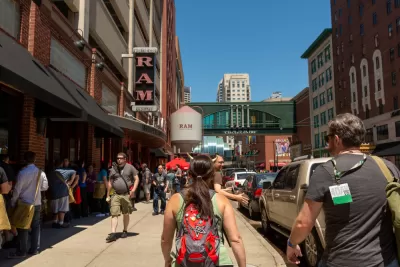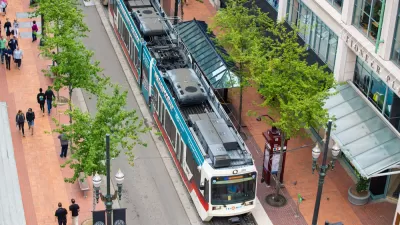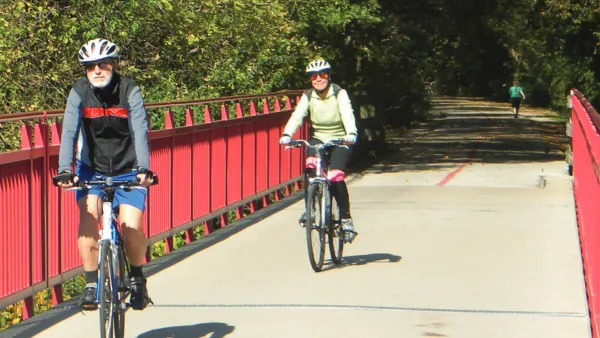In a planning area encompassing Hamilton, Hendricks, Boone, Johnson, Morgan, Shelby and Hancock counties in Indiana, streets with no sidewalks outnumber streets with sidewalks by more than two to one.

Kellie Hwang reports from Central Indiana, where a recently released a pedestrian infrastructure map in connection with an ongoing Regional Pedestrian Plan [pdf] effort lays out the pedestrian risk in and around the city of Indianapolis.
"On this map of Central Indiana, there's a collection of bright green lines in the center, with more scattered throughout. The rest of the map is a glaring web of bold, red angled lines protruding out of the Indianapolis metro area," reports Hwang.
Green indicates streets with existing sidewalks and other pedestrian infrastructure. Those kinds of streets total 1,704 miles in the region. "The red lines show 3,748 miles worth of gaps where pedestrian facilities don't exist, either on one side or both sides of the road," according to Hwang.
The Indianapolis Metropolitan Planning Organization published the map after a year and a half of into the Regional Pedestrian Plan, which updates the original version of the plan, completed in 2006.
FULL STORY: This map reveals a lack of pedestrian-safe infrastructure in Central Indiana

Planetizen Federal Action Tracker
A weekly monitor of how Trump’s orders and actions are impacting planners and planning in America.

Maui's Vacation Rental Debate Turns Ugly
Verbal attacks, misinformation campaigns and fistfights plague a high-stakes debate to convert thousands of vacation rentals into long-term housing.

Restaurant Patios Were a Pandemic Win — Why Were They so Hard to Keep?
Social distancing requirements and changes in travel patterns prompted cities to pilot new uses for street and sidewalk space. Then it got complicated.

In California Battle of Housing vs. Environment, Housing Just Won
A new state law significantly limits the power of CEQA, an environmental review law that served as a powerful tool for blocking new development.

Boulder Eliminates Parking Minimums Citywide
Officials estimate the cost of building a single underground parking space at up to $100,000.

Orange County, Florida Adopts Largest US “Sprawl Repair” Code
The ‘Orange Code’ seeks to rectify decades of sprawl-inducing, car-oriented development.
Urban Design for Planners 1: Software Tools
This six-course series explores essential urban design concepts using open source software and equips planners with the tools they need to participate fully in the urban design process.
Planning for Universal Design
Learn the tools for implementing Universal Design in planning regulations.
Heyer Gruel & Associates PA
JM Goldson LLC
Custer County Colorado
City of Camden Redevelopment Agency
City of Astoria
Transportation Research & Education Center (TREC) at Portland State University
Jefferson Parish Government
Camden Redevelopment Agency
City of Claremont





























